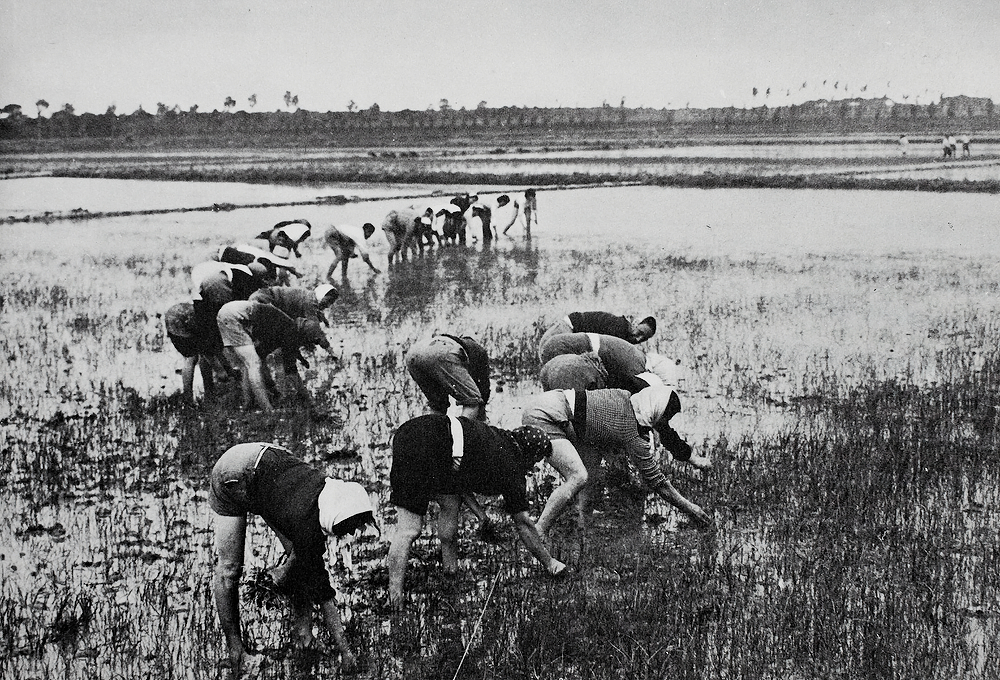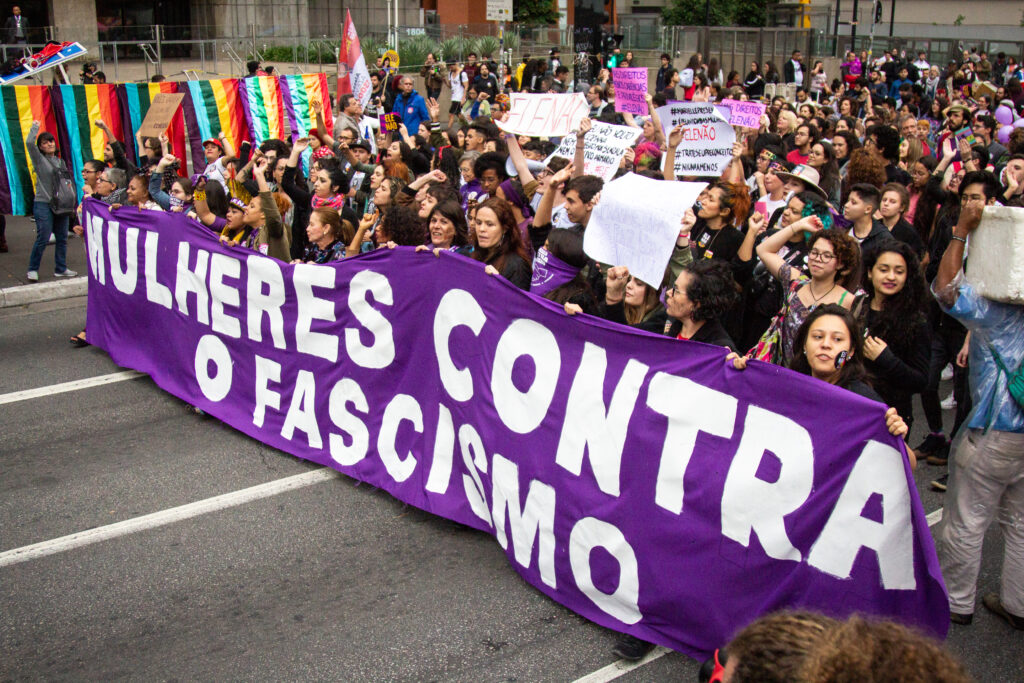BACK TO “BELLA CIAO” HOME PAGE
What is “Bella Ciao”?
Is it a work song, sung by women mondine (“weeders”) in the rice fields of northeast Italy to bemoan the hard conditions of their work?
Is it a World War II-era resistance song, narrating the fight of Italian partisans against the fascism of the mid-20th century?
Is it a contemporary protest song, taken up by (often left-leaning) resistance movements across the world?
Or is it a commercialized hit, popularized through the Spanish-origin Netflix show La Casa de Papel (“Money Heist”), which fashioned “Bella Ciao” into a plot point?
And what does it mean for one song to be all of these things?
A Lament of the Mondine

If you’ve come across “Bella Ciao” in your daily life, it is likely that the version you’ve come across is the “partisan” version.
However, whatever form “Bella Ciao” takes today, most sources agree that its melody stretches back to the 19th-century work song of the women rice paddy workers (mondine) of northeast Italy.
What’s distinct about this mondine version is not its melody, but its lyrics.
Take a look at the differences between the two sets of lyrics (from the original Italian):
| Mondine Version | Partisan Version |
| In the morning as I got up oh bella ciao, bella ciao, bella ciao, ciao, ciao in the morning as I got up to the rice paddy fields, I have to go. And amidst insects and mosquitoes oh bella ciao, bella ciao, bella ciao, ciao, ciao and amidst insects and mosquitoes a hard work I have to do. The boss is standing with his cane oh bella ciao, bella ciao, bella ciao, ciao, ciao the boss is standing with his cane and we work with our backs curved. Oh my God, what a torment oh bella ciao, bella ciao, bella ciao, ciao, ciao oh my god, what a torment as I call you every morning. And every hour that we pass here oh bella ciao, bella ciao, bella ciao, ciao, ciao and every hour that we pass here we lose our youth. But the day will come when we all oh bella ciao, bella ciao, bella ciao, ciao, ciao but the day will come when we all will work in freedom. | One morning I awakened, oh bella ciao, bella ciao, bella ciao, ciao, ciao one morning I awakened and I found the invader. Oh partisan carry me away, oh bella ciao, bella ciao, bella ciao, ciao, ciao oh partisan carry me away because I feel death approaching. And if I die as a partisan, oh bella ciao, bella ciao, bella ciao, ciao, ciao and if I die as a partisan then you must bury me. Bury me up in the mountain, oh bella ciao, bella ciao, bella ciao, ciao, ciao bury me up in the mountain under the shade of a beautiful flower. And all those who shall pass, oh bella ciao, bella ciao, bella ciao, ciao, ciao and all those who shall pass will tell me “what a beautiful flower.” This is the flower of the partisan, oh bella ciao, bella ciao, bella ciao, ciao, ciao this is the flower of the partisan who died for freedom. |
While there are some similarities in the lyrics (it’s not for nothing that each version ends with the word “freedom”), it’s clear that the situations of the narrators of each song are very different.
For example, the mondine version is narrated by women, whereas the partisan version—at least, as long as it’s associated with World War II—is narrated by men.
These differences in narrator and context then throw into relief the meanings of that haunting and beautiful refrain—“Oh bella ciao, bella ciao, bella ciao ciao ciao.”
As Marianna Giusti writes for Financial Times, the bella (“beauty”) of the partisan version is the girlfriend to whom the narrator must bid farewell as he goes off to join the partisans.
Not so in the mondine version. Giusti writes:
As in the wartime adaptation, the words “bella ciao” (“goodbye beautiful”) were sung thrice in the second line of each verse, but the identity of the bella the mondine are waving goodbye to remains unclear. It could be their beautiful youth, their freedom, or even themselves.
That interpretation holds up when we consider this stanza:
And every hour that we pass here
oh bella ciao, bella ciao, bella ciao, ciao, ciao
and every hour that we pass here
we lose our youth.
According to an article in Pummarola, an online arts, culture, and politics magazine documenting the Italian diaspora experience, the mondine version is considered to be at its most authentic in Giovanna Daffini’s interpretation, as she was a folk singer who herself labored in the rice paddies as a child.
So, given these origins, how does this song become a partisan, war-time rallying cry?
And what does it mean for a song about women’s labor and oppression to be superseded by a song about armed conflict?
A War-Time Rallying Cry

The origins of the partisan version of “Bella Ciao” in World War II are romantic. They are also apocryphal.
As the popular story goes, this mondine version was adapted to the struggle against Mussolini and Nazi occupiers during World War II. It was a rallying cry for partisans struggling against right-wing fascism.
However, more than 80 years after WWII, there isn’t much evidence to show that the song was actually sung by partisans during this conflict.
Nevertheless, the story of “Bella Ciao” being rooted in mid-20th-century anti-fascist struggles is deeply meaningful. As Giusti writes, it is often sung during April 25th Liberation Day commemorations and celebrations in Italy.
It’s these WWII origins, and painful memories of freedom hard won through many lives lost, that also lead many in the older generation of Italians to see it not as a light celebration song but as a solemn remembrance.
Mark Zitti, head of the Italian swing band The Fratelli Coltelli, told Saeed Saeed of The National that there is a stark difference between how younger generations and older generations tend to understand the mood of the song.
As Zitti says to Saeed:
For many Italians, particularly those who are older, this song is not about celebration. It is about war and it brings back many painful memories.
The partisan version of “Bella Ciao” has been performed by countless artists and bands. Here is a version from Fonola Band, featuring both men and women singers.
Yet, “Bella Ciao” did not stay exclusively within the WWII remembrances of Italian communities.
In the mid-20th century, the partisan version began to travel, becoming an anthem for resistance movements worldwide.
An Anti-Fascist Anthem
Starting in the decades after WWII and the Italian Civil War, “Bella Ciao” began spreading beyond Italy. It was taken up by anti-fascist movements across the world, especially leftist movements.
Giusti writes that the first known performance of the song outside of Italy was in 1964 by French singer Yves Montand, whose family escaped Tuscany during the height of fascism in the country.
The partisan version has spread far and wide since then.
Here are just some of the places it has recently shown up, whether as direct translations or through adapted lyrics using the same melody:
- at the 2013 Gezi Park protests in Istanbul, which were highly critical of the AKP government headed by Recep Tayyip Erdoğan;
- around the anti-Bolsonaro #EleNão protests in Brazil in 2018;
- among Ukrainian resistance to the ongoing Russian invasion of Ukraine;
- during the 2022 protests by Iranian women against the compulsory hijab mandated by the Islamic Republic (sparked by the killing of Kurdish woman Jina [Mahsa] Amini by Iranian police);
- at a military checkpoint in Hebron in Israeli-occupied Palestine, where it was sung by Italian visitors.

The political ramifications of the song aren’t just felt in its use by people’s movements—they are also felt in government reactions to the song.
According to Diana Lucarino-Diekmann writing for La Gazzetta Italiana, the song has been banned in the past by Italian municipalities controlled by the right-wing Lega Nord.
Once a women’s work song, by the 21st century, this anthem of resistance had spread far and wide. But in the 2010s, it hit a new, explosive level of popularity.
A Popular Hit

Throughout its history, “Bella Ciao” has had deeply political connotations. While the partisan version is often first to come to mind where the politics of “Bella Ciao” is concerned, these concerns are wrapped up in the mondine version as well, as this song highlights workers’ rights and freedom.
As written in Pumarrola:
The workers would spend their workdays with their bare feet in water up to their knees and their backs bent for many hours. The atrocious working conditions, long hours and very low pay led to constant dissatisfaction and led, at times to rebellious movements and riots in the early years of the twentieth century. The struggles against the supervising padroni were even harder with the abundance of clandestine workers ready to compromise even further the already low wages just to get work.
Thus, it is not just the anti-fascist dimensions of the partisan version but also the anti-capitalist dimensions of the mondine version that have solidified the song as an anthem on the political left.
However, the popularization of “Bella Ciao” by the hit show La Casa de Papel (“Money Heist”) has added yet new dimensions to the meaning of this song.
Originally aired on the Antena 3 network in Spain, Money Heist was picked up by Netflix in 2018 and renewed beyond its initial limited run.
The series has three seasons, which follow two heists led by the character of El Profesor (“The Professor”) during the financial crises of 2007 and 2008. These heists target the Royal Mint of Spain and the Bank of Spain.
The partisan version of “Bella Ciao” is not just part of the soundtrack of the series. It is a main feature of its plot, embedded in the show’s story of resistance—in this case, against capitalist and neoliberal elites.
As Celia Fernandez notes in an article about the show’s use of the song, the character of Tokyo narrates how the song drives the actions of The Professor:
The life of The Professor revolved around one idea: Resistance. His grandfather, who had fought against the fascists in Italy, taught him the song—and he taught it to us.
Tokyo, character in La Casa de Papel [Netflix]
What’s especially notable about the show’s use of the song is that it turns up in multiple interpretations across the story. There are versions with the original Italian lyrics (both raucous and mournful), as well as entirely instrumental versions.
There is a reason why the song, sung by Manu Pilas, toes the line between celebration and disaster—a reason why the show features both energetic versions and sorrowful versions.
As Hannah Shaw-Williams writes for Screenrant:
The Money Heist song embodies the show’s theme of resistance, but its lyrics also serve as an omen of death – which the gang have encountered several times throughout their two major heists.
Yet, despite the fact that the show seems to stay true to the resistance themes of “Bella Ciao,” it’s worth questioning whether the song has now become so popularized that it is moving away from these themes.
When looking at the number of “Bella Ciao” versions that show up on a simple Spotify search, it is clear that the song has proliferated. This popularization surely extends the song’s resistance themes to new audiences, but for those who might lack the context of its lyrics (especially if the lyrics are in a language they don’t speak), one wonders where it’s protest message ends and another message begins.
Here are just some of the genres where covers and adaptations of the song have popped up since Money Heist came on the global scene in 2018 through Netflix:
Acoustic (Strings) — Chloé Stafler (2018)
Pop — Behin and Samin Bolouri (*Cited above as the sisters singing the song during the 2022 protests in Iran; they actually released their adaptation in 2021)
Dance — Alok, Bhaskar & Jetlag Music, feat. Andre Sarate (2018)
Medieval Folk — Middle Ages (2020)
Lofi Hip Hop — Lofi Fruits (2020)
There are also multiple versions that have been covered specifically for or in conversation with Netflix’s Money Heist.
Some examples:
Electronic Dance Music — Steve Aoki & Delia (2018)
Latin Pop — Becky G (2021)
Acoustic (Guitar, without lyrics) — Maneli Jamal (2020)
Acoustic (Piano, without lyrics) — Riyandi Kusuma (2020)
As demonstrated by the examples above, which are just a fraction of the hundreds of versions available through Spotify alone, “Bella Ciao” has become better known globally than it ever has been.
It also transcends genres. Originally a folk song, it has been adapted for pop, rock, dance, hip hop, instrumentals (including guitar and piano), and even lofi beats.
The fact that many versions appearing after 2018 include explicit references to La Casa de Papel also begs the question of how the song’s meaning might be changing.
As “Bella Ciao”—an anti-fascist and anti-capitalist protest song—is becoming more widely known because of its inclusion in a television series spread by a major global streaming company, is it at danger of losing its resistance roots, at least for those whose only introduction to the song is through this popular show?
WHERE TO NEXT?

The Stories and Moods of “Bella Ciao”

Adapting “Bella Ciao”: A Vignette
